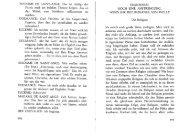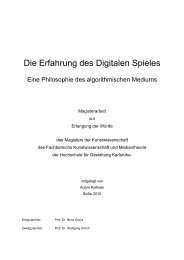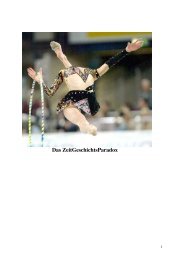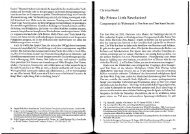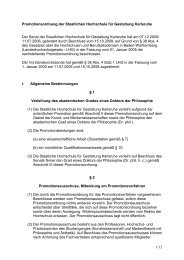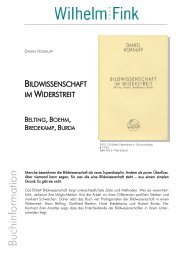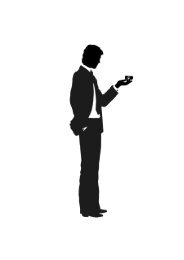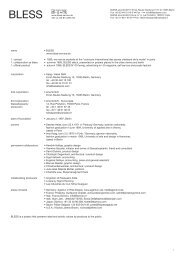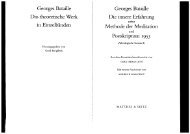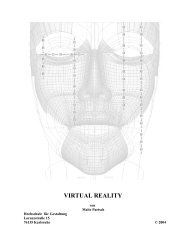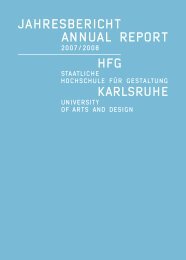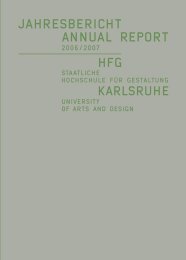HfG Karlsruhe Jahresbericht Staatliche Hochschule für Gestaltung ...
HfG Karlsruhe Jahresbericht Staatliche Hochschule für Gestaltung ...
HfG Karlsruhe Jahresbericht Staatliche Hochschule für Gestaltung ...
Erfolgreiche ePaper selbst erstellen
Machen Sie aus Ihren PDF Publikationen ein blätterbares Flipbook mit unserer einzigartigen Google optimierten e-Paper Software.
MK MA<br />
114 Prof. Michael Bielicky 115<br />
Digitale Medien /Digital Media<br />
mainly focused on developing useful methods and concepts which will allow us to find an-<br />
swers to the question of the exponential growth of digital information in our era, in the form<br />
of works of art, both content- and form-wise.<br />
The third seminar, the “Alchemist’s Chest” [die “Alchimistenkiste“], led the students into the<br />
unknown waters of the history of media art, where they familiarized themselves with rare<br />
works from the field of experimental film and other time-based media.<br />
Stefan Dösinger, in his teaching appointment, “Bastard Spaces,” analyzed the fusion of the avatar<br />
reality in Second Life with our physical reality and conducted exercises with the students<br />
accordingly.<br />
Agronomist and social activist Ephrem Rukundo from Rwanda, in his impressive lecture,<br />
“Power Off,” confronted our “energy-saturated” students with the Rwandan reality of dramatic<br />
power shortage. Most of our students realized for the first time that industrial nations like<br />
Germany would collapse without their energy supply, and consequently are actually quite<br />
fragile constructs. This recognition made some of them view their activities in the field of<br />
Media Art in a different light and gave them much to reconsider.<br />
Croatian artist and exhibition designer Darko Fritz visited our department and presented his<br />
work. He then guided us through the important exhibition “bit international” at the ZKM<br />
[Center for Art and Media <strong>Karlsruhe</strong>], which he had curated together with Margit Rosen.<br />
In the spring semester, we invited renowned art critic Konstantin Akinsha to talk about the<br />
obvious influence of early film on the emergence of abstract painting, as well as about the<br />
projection of moving images in urban, public space in Russia at the beginning of the 20th<br />
century.<br />
In the past academic year, we also focused increasingly on specific technical disciplines by<br />
conducting workshops with various experts. Dominik Rinnhofer, for example, introduced us<br />
to the complexities of what is known as “motion capture tracking” technology (EyCon), a<br />
technology that can mainly be used in the field of interactive installations or in different performative<br />
disciplines.<br />
The brothers Andreas and Michael Rentschler from the Department of Computer Science at<br />
the Technical University <strong>Karlsruhe</strong> had developed what they call the “Visual Cube.” In an intensive<br />
workshop, they gave our students the opportunity to develop projects specifically for<br />
the “Visual Cube.”<br />
Albert Radel taught a group of students how to use “stop motion” animation technology. It is<br />
to be used for the realization of a highly ambitious project in the next two semesters.<br />
Last but not least, our students benefited from a workshop on “Arduino Processing” held by<br />
Alex Wenger, author of the very first book on this specific technology that makes it possible to<br />
program microprocessors (used pretty much everywhere, today) in a simple but brilliant way.<br />
At the end of the spring semester, we hosted a three-day conference and training for the first<br />
time at the <strong>HfG</strong>-Atrium [<strong>HfG</strong> Lichth_fe]. 150 programmers from the <strong>Karlsruhe</strong> region attended<br />
and enjoyed the “GPN 8: Goulash Programming Nights CCC <strong>Karlsruhe</strong>” [GPN 8: Gulasch<br />
Programmiern_chte CCC <strong>Karlsruhe</strong>]. Our students also greatly benefited from this conference,<br />
which is to become a regular event at the <strong>HfG</strong> in the next years.<br />
“Outside – Inside” was the title of our double exhibition at the end of the spring semester. At<br />
the fascinating ruin of the Frauenalb Convent in the Albtal [Valley near <strong>Karlsruhe</strong> between<br />
Ettlingen and Bad Herrenalb], our students displayed very different projects in one night<br />
which had been designed especially for this location. Visitors could see projections on artificial<br />
fog and experience interactive, telematic, but also pyrotechnical projects that were particularly<br />
impressive in such a bizarre environment.<br />
During the annual exhibition “Sommerloch,” the students displayed ambitious projects, like<br />
the interactive piece by Thomas Kühn that was controlled by the visitors’ brain flows or the<br />
telematic piece by Mariane Schmidt that allowed virtual handshakes via long distances. We<br />
are particularly pleased to announce that the latter was selected, funded and given an award<br />
by the worldwide most important festival in the field of Digital Media, the “Ars Electronica”<br />
in Linz.<br />
MK MA<br />
█ Inflation<br />
Stefan Rosinski



